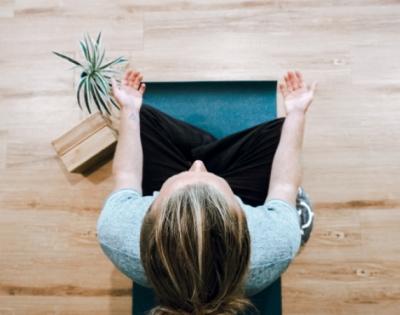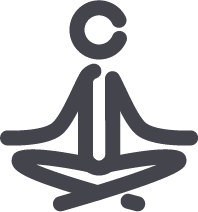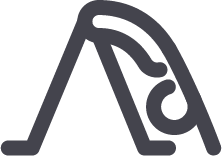
Just about everyone experiences trauma. Trauma can be anything that brings large amounts of distress emotionally and/or physically that can last long after the traumatic experience. Something that is traumatic to one person may not seem traumatic to another, so people might minimize their own traumatic experiences, but all trauma and all experiences are valid. No matter what kind of trauma someone has gone through, there are a variety of treatments and therapy models that can help. These might include EMDR or Trauma-Focused Cognitive Behavioral Therapy (TF-CBT). Trauma-sensitive yoga can be used along with other forms of therapy to help treat trauma.
What is trauma-sensitive yoga?
Trauma-sensitive yoga is a body-centered practice that helps manage and decrease symptoms related to trauma. One main focus during trauma-sensitive yoga is switching out of our stress response (“fight, flight, freeze, or fawn”), which is our sympathetic nervous system, to our “relaxation” response, which is our parasympathetic nervous system. This is done through a combination of breathing techniques, physical postures, and meditation practices. The premise of trauma-sensitive yoga is based on the understanding that trauma gets stuck in the body, and that we can work with the body to help release trauma and decrease symptoms.
What are the benefits of trauma-sensitive yoga?
Trauma-sensitive yoga can be beneficial not only to those who have experienced trauma, but also to those struggling with anxiety, depression, and other mental health issues. Benefits include:
- Decreased anxiety and depressive symptoms
- Increased feelings of groundedness (decreased dissociation symptoms)
- Improved ability to calm the mind, stay present, and relax
- Enhanced concentration and focus
- Increased ability to tolerate distress/uncomfortable feelings
- Reduced irritability and feelings of anger
Trauma-Sensitive Yoga Practices To Do Today!
Breathing Techniques
Belly Breath: Sit tall, stand tall, or lay down. As you inhale, imagine breathing into your belly and feel your belly expand. As you exhale, slowly release all of the air from your lungs as you feel your belly fall. Repeat.
Benefits: Belly breath involves taking full, complete breaths, which signals to the brain and body that we are safe. This switches us out of our stress response and into our relaxation response. This switch also happens during belly breath due to it stimulating the vagus nerve that runs through the stomach.
Alternate Nostril Breath: Sit or stand tall. With your right hand, tuck in your middle three fingers so just your pinkie and thumb are out. Completely release all the air from your lungs to start, then on your inhale, press your thumb to your right nostril and breathe in slowly through your left nostril. Before you exhale, switch so the pinkie is closing the left nostril and breathe out the right nostril. Then, slowly breathe in through the right nostril again. Before you exhale, close off your right nostril and breathe out the left. That is one round. Start the next round by breathing in again through your left nostril and repeat the steps above. It can help to watch a video on how to do practice this breath.
Benefits: Alternate nostril breath bilaterally stimulates the brain, which helps the two hemispheres of the brain communicate. This produces both a calming and energizing effect. It helps to balance energy levels.
Yoga Flow
 |
 |
|
|||
| Easy Seated Pose | One Knee to Chest Flow | Modified Low Lunge to Half Pyramid Flow | Child’s Pose | Lizard’s Lunge | Final Relaxation/Savasana |
| Cross your legs and sit tall, imagining that you are balancing a book on top of your head. Practice Belly Breath for about 1 minute in Easy Seated Pose. Place one hand on your belly, feeling it rise on your inhale and fall slowly on your exhale. Sit either on a yoga block, pillow, folded up blanket, or chair if it is uncomfortable to sit cross-legged. (1-2 minutes) | Lay on your back with your knees hugged in towards your chest. On your exhale, extend one heel toward the front of the room and hover your heel just a few inches above the ground, pointing your toes towards the sky while the other knee is still pulled in towards the chest. Make sure to pull your low back towards the ground, keeping your core engaged. On your inhale, hug that knee back in towards your chest and switch sides. Repeat. (5 to 6 times each leg) | From all fours, start with one foot forward in a lunge with the back knee on the ground. On your inhale, walk back into Half Pyramid so the front leg is extended straight in front of you (with a small bend in the front knee) and your hips are stacked over your back knee. On your exhale, walk back into Low Modified Lunge. Focus on feeling the ground beneath you as you move. Repeat 4-5 times, then switch so the other leg is forward. (4 to 5 times each side) | From all fours, bring your hips to your heels with your arms out in front of you. Rest your forehead on the ground or a block/book if that feels more comfortable for the neck. Let your tailbone get heavy and practice belly breath. (4 to 5 breaths) | From all fours, step one foot forward. Bring your hands along the inside of your foot and walk your foot out towards the side of the mat, then drop your knee out to the side. Hold and breathe for 4-5 breaths. Then, switch sides and repeat. (4 to 5 breaths each side). | Choose to either lay down or sit tall in Easy Seated Pose. Get comfortable! Listen to a meditation or just simply rest while focusing your attention gently on the present moment. (1 minute - 15 minutes, or more!) |
| Benefits: Having good posture and practicing belly breathing helps to activate the relaxation response (parasympathetic nervous system) and helps us feel grounded. | Benefits: These movements warm up the psoas muscle, the muscle that connects the lower body to the upper body and runs through the hips. When we operate in our stress response, the psoas muscle contracts. If we frequently operate in our stress response, this can create chronic tension and releasing this tension can help switch us back into our relaxation response. | Benefits: Modified low lunge and half pyramid flow aid us in feeling grounded and calm. This flow also helps to release the psoas muscle, a muscle that plays a crucial role in our stress response and relaxation response as discussed above. | Benefits: Child’s pose is a grounding posture that can help the body feel safe. It also helps stimulate the vagus nerve that runs through the forehead all the way down through the belly. Stimulating this nerve helps to switch us out of our stress response and into our relaxation response. | Benefits: Lizard’s lunge is another posture that targets the psoas muscle. This deep hip opener can sometimes cause shaking of the body, which can be helpful as it is the body’s natural way of releasing trauma, stress, and tension. | Benefits: Just like it is important to strengthen and stretch the body, it is also important to rest and restore. This is a time to give not just the body rest, but also the mind. Try doing a meditation or simply practicing mindfulness. |
Note: Sometimes poses involving releasing and warming up the psoas muscle causes the body to shake, which is the body’s natural way of coping with and releasing trauma and stress from the body.




